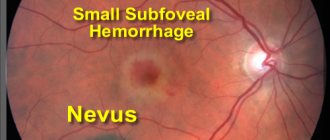Causes of retinitis
The inflammatory process occurs due to the body's defense reaction, in response to the penetration of pathogenic microorganisms into the retina. Often the cause is hidden in bacterial damage. Viral and fungal infections are rare.
An endogenous type of pathology develops in people who suffer from leukemia, diabetes and autoimmune diseases. The exogenous form occurs as a result of injuries, burns of various etiologies and harmful radiation.
The main causative agents of the inflammatory process:
- streptococci, staphylococci, pneumococci;
- toxoplasma;
- chlamydia;
- meningococci;
- Brucella pathogens;
- herpes viruses;
- adenoviruses;
- influenza, chickenpox and measles viruses.
There is also retinitis pigmentosa. This disease is inherited. The reason lies in violations of genes that are responsible for the healthy structure of the retina. Pathology is transmitted from parents to children. The risk of genetic predisposition is quite high.
Symptoms of the disease
When the retina of the eye becomes inflamed, retinitis develops with characteristic symptoms:
- deterioration in vision clarity;
- altered color perception;
- loss of areas of vision (tunnel vision);
- poor adaptation of the eyes in the dark (dark blindness);
- distorted perception of objects;
- flashes, sparks, lightning before my eyes.
Clinical manifestations differ somewhat depending on which part of the retina is affected. With macular changes, mainly central vision is affected, and with damage to peripheral zones, peripheral vision is affected.
Progression of the disease leads to the development of complications (neuroretinitis of the eye, hemorrhages, retinal detachment).
How a person with retinitis sees:
Classification of retinitis
The main classification of pathology is divided into endogenous and exogenous retinitis. Each of them has certain types of manifestation. The following endogenous forms of the disease are divided:
- against the background of severe infectious diseases: tuberculosis, syphilis, toxoplasma, brucellosis, sepsis;
- retinitis, which occurs due to metabolic disorders and blood diseases: diabetes, leukemia;
- exudative, herpes zoster retinitis of unknown etiology;
- hereditary retinitis pigmentosa and its forms (in ophthalmology this type is defined as retinal degeneration).
Exogenous species are divided into: solar, traumatic. They can also be identified by location. There are widespread, localized and disseminated retinitis. Inflammation affects the destruction of the retina and choroid. Scar tissue may form at the site of infection
Retinitis is accompanied by destruction of the nerve elements of the retina. The vascular reaction leads to the manifestation of vasculitis. There may be blockage of blood vessels and severe hemorrhages.
Classification
Inflammation of the retina of the eye can be classified according to several criteria.
Retinitis depending on the course:
- spicy;
- chronic.
By location of the lesion:
- localized (limited area);
- widespread (more extensive changes);
- disseminated (damage to the entire area of the retina).
According to the mechanism of occurrence:
- exogenous (caused by external reasons);
- endogenous (caused by internal diseases).
Endogenous are divided into:
- infectious - bacterial, viral (tuberculosis, toxoplasma, syphilitic, cytomegalovirus, etc.);
- retinitis caused by internal diseases (diabetes, hypertension, leukemia, etc.);
- hereditary or retinopathy (retinitis pigmentosa, Coats' retinitis);
- of unclear nature (shingles, exudative, etc.).
Hereditary forms (retinitis pigmentosa, Coats) can be inherited in three ways.
Exogenous are divided into:
- toxic (body poisoning);
- traumatic (injuries, blows);
- solar (ultraviolet exposure to the sun).
To watch a video about how a person with retinitis pigmentosa sees:
Symptoms of retinitis
It is important to consider that there are no sensory endings in the retina. When inflammation develops, a person does not feel pain. This affects the manifestation of retinitis symptoms. Signs of pathology depend on the location of the inflammation. Main clinical manifestations:
- Significant decrease in vision. Mainly appears with central localization. This part is responsible for visual acuity, so the patient begins to see poorly.
- Color vision impairment. Vision is distorted, a spot appears before the eyes. Symptoms also appear when the retina is damaged in the central part.
- Photopsia. Lightning and bright flashes of light appear before your eyes. Occurs due to irritation. Disturbances can manifest themselves with central and peripheral inflammation.
- Violation in the location of visual fields. The source of inflammation in this case is localized in the fundus. Such signs are characteristic of peripheral lesions.
- Retinitis pigmentosa is hereditary. A narrowing of the visual fields gradually develops. Initially, the symptoms are practically unnoticeable. They can only be seen by an ophthalmologist during a special examination. Then difficulties begin to arise with identifying objects. This type of pathology has the character of slow development.
Symptoms may vary in severity in each patient.
Symptoms
Acute retinal necrosis can manifest itself in quite a variety of ways. Sometimes pain occurs a few days after the onset of the disease. In some cases, the disease is practically asymptomatic.
With this disease, there is a rapid decrease in visual acuity, which first affects one eye and then spreads to the neighboring one.
Typically, when an infection occurs, symptoms and signs appear in the following order:
- Multifocal infiltrates in the retinal area, having a white-yellow color;
- Infiltrates that tend to merge, necrosis in the retinal area, damage to the macula.
Diagnosis of retinitis
The following ophthalmological methods are used for diagnosis:
- visometry;
- definition of PZO;
- computer perimetry;
- color perception tests;
- ophthalmoscopy;
- biomicroscopy;
- X-ray.
After the examination results, the etiology of this disease can be established. In this case, it is very important to study the condition of the fundus. The tuberculosis type is accompanied by damage to the retina with a large number of small foci of inflammation. The syphilitic type of the disease causes severe swelling, pigmentation and atrophy of the membrane.
With toxoplasmosis retinitis, almost all eye membranes are affected. During ophthalmoscopy, the doctor observes a yellow lesion. The sunny appearance has red areas of inflammation. During diagnosis, the ophthalmologist often detects the presence of scotomas and a violation of the PZO. Contrast angiography can detect vascular changes. They can expand or contract. It is very important to study their condition.
To diagnose a bacterial or viral type of disease, laboratory blood tests are performed. If the doctor suspects that the pathology has arisen against the background of autoimmune diseases, then it is necessary to conduct immunological tests.
If the disease has an unknown etiology, examination of the following specialized specialists will be required: venereologist, infectious disease specialist, diabetologist, endocrinologist, rheumatologist. Systemic diseases often cause the development of a certain type of pathology that affects the retina.
What is retinitis
To understand the diagnosis, you need to have an understanding of the anatomy. The retina is the retina of the eye, responsible for receiving images and transmitting them along nerve pathways to the visual areas of the brain. The retina contains photoreceptors:
- responsible for color perception and visual acuity - cones;
- responsible for lateral vision (peripheral), for vision in low light - rods.
Based on this, it becomes clear that with inflammation of the retina, degeneration of rods and cones occurs, leading to impaired visual functions.
Treatment of retinitis
Treatment is prescribed after a full diagnosis and determination of the etiology of the disease. This ensures correct and safe therapy. Treatment is aimed at eliminating the inflammatory process. For this, the following groups of drugs are prescribed:
- antibiotics for internal and local use;
- eye drops and ointments based on corticosteroids;
- anti-inflammatory and antibacterial drops.
Medicines based on acyclovir and interferon are also prescribed. Subconjunctival injections will be helpful. Specific retinitis requires taking medications that eliminate a specific pathogen. Complex therapy consists of taking vasodilators and antispasmodics. Additionally, it is necessary to take medications to improve metabolic processes. Vitamin complexes are prescribed as auxiliary therapy.
In some cases, it is recommended to undergo the procedure with electrophoresis. These pathologies can cause retinal detachment. The only treatment for this complication is laser coagulation.
Diagnostics
A comprehensive examination of a person. To make a diagnosis:
- Examination of the fundus using ophthalmological instruments (ophthalmoscopy, biomicroscopy, diaphanoscopy).
- Ophthalmological tests (determination of visual fields, color testing, visometry).
- Optical coherence tomography.
- Fluorescein angiography of retinal vessels.
To determine the cause of retinitis, other tests are prescribed (ELISA, PCR, culture of media for pathogens), and the person is referred for consultation to other doctors to look for somatic pathologies.
In the following video, an ophthalmologist at an eye clinic talks about diagnosing retinitis:
Complications of retinitis
Each type of such inflammation can cause hemorrhage. It penetrates the retina or vitreous body. Inflammation may also occur, which will spread to other tissues of the visual organs. All complications are dangerous if medical assistance is not provided in a timely manner. The most dangerous is considered to be loss of vision.
It is worth noting that in rare cases, simultaneous inflammation of the retina and optic nerve may occur. Retinitis pigmentosa is a genetic disease. It is impossible to cure it. Manifests itself with mild symptoms. It affects the visual apparatus slowly and gradually. May cause vision loss. They prescribe drugs that slow down such processes, but cannot completely get rid of them. Retinitis, which occurs against the background of immunodeficiency, is also difficult to treat.
Acute retinal necrosis
- History of the discovery of the disease
- Etiology
- Treatment
Acute retinal necrosis (ARN) is a rare and extremely severe disease characterized by rapidly progressing peripheral necrotizing retinitis, occlusive vasculitis, an inflammatory reaction in the vitreous body and anterior chamber, followed by the development of retinal detachment in 65%-72% of patients. Most often, the cause of ARN development is viruses varicella-zoster and herpes simplex.
The viral etiology of acute retinal necrosis is generally accepted; However, another infectious agent, in particular Mycobacterium tuberculosis, can additionally act as the causative agent of the disease, in which case we are talking about a so-called mixed infection.
In acute retinal necrosis, predominantly the peripheral parts of the retina are involved, while the central region of the retina, as a rule, remains intact.
The PCR diagnostic method for acute retinal necrosis is not always possible to identify the DNA of the pathogen in a vitreous biopsy; the most informative is the study of a retinal biopsy.
History of the discovery of the disease
The clinical triad of acute panuveitis, retinal occlusive arteritis, and peripheral retinal necrosis was first described in the medical literature as Kirisawa uveitis in 1971. Later, A. Martenet in 1976, NJ Young and AC Bird in 1978 introduced the term “acute retinal necrosis”.
In 1982, WW Culbertson et al performed light and electron microscopy of tissue from the enucleated eye of a patient with acute retinal necrosis. At the same time, histological examination showed the presence of eosinophilic intranuclear inclusions in the retinal cells, and electron microscopy showed the presence of herpes group viruses in all layers of the affected retina. Subsequently, the same authors confirmed the viral etiology of the process by identifying the herpes zoster virus using an immunohistochemical method and reported the first experience with the intravenous use of acyclovir for the treatment of acute retinal necrosis.
In 1990, Forster DJ and colleagues first described another form of necrotizing herpetic retinopathy - progressive necrosis of the outer layers of the retina. Evidence that cytomegalovirus (CMV) may be the cause of retinitis was obtained in 1964. CMV retinitis is described mainly in patients with immunodeficiencies, most often in patients with AIDS (including iatrogenic) or with congenital infection, but there are also cases in healthy patients with systemic connective tissue diseases.
Only in 1994 did Holland G. and the American Uveitis Society introduce clear criteria for the disease
- the presence of one or more foci of retinal necrosis with clear boundaries on the periphery of the retina;
- rapid progression in the absence of antiviral therapy;
- circular spread; occlusive vasculopathy involving arterioles;
- inflammatory reaction in the vitreous body and anterior chamber;
- neuropathy or optic atrophy, scleritis and pain.
In the absence of the above criteria, the following definitions are also proposed:
- necrotizing herpetic neuropathy,
- cytomegalovirus (CMV) retinopathy (with a characteristic clinical picture)
- progressive outer retinal necrosis (PORN), which occurs in patients with HIV and is caused by the varicella-zoster virus.
Etiology
It was noted that the occurrence of acute retinal necrosis is not associated with the age, gender and state of the patient’s immune system.
According to WHO, 60–80% of the population is infected with viruses of the herpes family. Based on the results of polymerase chain reaction (PCR) of the retina obtained from a biopsy, the Epstein-Barr virus, herpes simplex virus (HSV) types 1 and 2, and CMV were identified as the causative agents of acute retinal necrosis. Other authors consider PCR diagnostics regarding the moisture of the anterior chamber or vitreous body to be the key to determining the etiology. In this case, differential diagnosis was carried out with atypical toxoplasmosis and other forms of retinovasculitis, in particular, such as Behçet's disease.
Cases of non-necrotizing herpetic retinopathy were described for the first time only in 2003. It is noted that they often mask other diseases of the posterior segment of the eye, such as atypical posterior uveitis in Behçet's disease, retinal vasculitis and shotgun chorioretinopathy. Most often they are bilateral.
The literature also describes clinical cases of the disease after vaccination against herpes zoster. There are two types of subcutaneous vaccine. Primary vaccination is carried out with Varivax (two injections, small doses), and revaccination with Zostavax (one injection, large dose).
ORN syndrome is observed relatively rarely and, as a rule, occurs in young adults, and its development in children has been described only in isolated cases, including during the neonatal period. In children, the disease is more aggressive with severe vitriitis and membrane formation in the vitreous body.
Treatment
There is still no unified approach to the treatment of acute retinal necrosis; it is unclear whether the use of aspirin, corticosteroids, barrier laser coagulation and prophylactic vitrectomy is advisable.
But according to the literature, in patients who underwent early vitrectomy, intraoperative lavage of the vitreal cavity with acyclovir, demarcation laser coagulation of necrotic foci of the retina with or without extrascleral filling and tamponade with gas or silicone oil, rhegmatogenous retinal detachment develops 2 times less often and at the same time practically There are no cases of subatrophy of the eyeball.
Some authors argue that acute retinal necrosis caused by the varicella-zoster virus is more serious and progresses faster than those caused by HSV. Therefore, treatment should be started with higher doses of acyclovir until the causative virus is detected in the intraocular fluid using PCR. If the results of PCR diagnostics confirm the presence of HSV as the causative virus, the dosage of the drug should be reduced to 10 mg/kg 3 times a day. Intravenous therapy is followed by 6 weeks of oral antiviral therapy.
Other investigators have advocated the adjunctive use of intravitreal injection of ganciclovir or foscarnet in the treatment of patients with severe cases of acute retinal necrosis.
Treatment of ONS begins with intensive antiviral and anti-inflammatory therapy. Conservative treatment stops the inflammatory process, but does not prevent the possibility of developing retinal tears and detachment.
In 1991, the standard of care for patients with acute retinal necrosis with acyclovir was developed. The recommended regimen is intravenous acyclovir at a dose of 10 mg/kg every 8 hours (or 1500 mg/m2) per day for 5 to 10 days, then oral acyclovir at a dose of 400 to 800 mg 5 times a day for an additional 6 to 12 weeks. One and a half months of oral antiviral drugs were determined as the minimum period of therapy, since according to various authors, the involvement of the fellow eye in the process occurs in a third of cases in a period from the first few weeks to several months or even years.
Today, it is better to use the drug Valacyclovir orally - it is a prodrug of acyclovir, upon absorption it turns into acyclovir, has higher bioavailability and a longer half-life, and is also taken with a smaller frequency (2 times a day).
Active dynamic monitoring of patients who have undergone ANS allows for timely detection of changes requiring surgical treatment, which leads to better functional and anatomical results.
The method of surgical treatment of ONS and its complications is vitrectomy, which is performed in cases of retinal ruptures and detachments, in cases of severe vitreous opacification, and rough vitreoretinal moorings. It is advisable to carry out surgical treatment in patients before the formation of retinal detachment with severe traction syndrome with or without retinal breaks.
Achieving a good anatomical result (attachment of the detached retina, restoration of the transparency of the optical media) is possible in most cases of surgical treatment of ONS, but the functional results of treatment of ONS depend on the extent of the necrosis zone in the fundus, the initial functional and anatomical state of the retina and vitreous body.
Prevention
Every person will need preventive measures, not just those at risk. In the presence of tuberculosis, syphilis, toxoplasma, timely treatment of the underlying diseases is necessary. In addition, it is necessary to constantly monitor the condition of the body and undergo an examination by an ophthalmologist. Only after a full examination can the etiology and drug therapy be determined.
Retinitis is a common disease in ophthalmology. A characteristic symptom is inflammation of the retina. The reason lies in the infection of the retina by pathogenic microorganisms. They enter the body from the external environment. Often the disease occurs against the background of diabetes mellitus and autoimmune diseases. Factors may also include injuries, burns of various etiologies, and harmful radiation.
Treatment is prescribed by an ophthalmologist after a full examination. Additionally, you will need to consult a dermatologist, therapist, or endocrinologist. Patients are prescribed antibiotics, antiviral drugs, antioxidants, and antispasmodics. Sometimes it is possible to almost completely eliminate inflammation. But vision deterioration is an irreversible process. It is important to maintain good personal hygiene to avoid infection.
Treatment
For the treatment of progressive retinal necrosis, intravenous ganciclovir is used. Sometimes foscarnet is also prescribed. If therapy is stopped within a few weeks, macular necrosis and retinal detachment occur, causing patients to lose vision. About half of patients with acute retinal necrosis die within five months.
Therapeutic treatment regimens for acute retinal necrosis include:
- Acyclovir, which is initially prescribed for two weeks at a dose of 10 mg per kg per day in three doses. Thereafter, for three months, the dose should be 800 mg five times a day. Often, after starting to take acyclovir, no visible improvements are observed during the first week. Acicrovir therapy should be discontinued gradually, since the risk of damage to the second eye is very high.
- Famciclovir is also an antiviral drug. It is prescribed 500 mg three times a day for three months. This drug is used in patients who have not experienced clinical improvement while taking acyclovir.
- Prescription of systemic steroids is allowed for a short period after antiviral therapy.
- To prevent complications associated with vascular obstruction, it is advisable to prescribe aspirin.
In some cases, it is advisable to perform argon laser photocoagulation, which creates chorioretinal adhesion. This is necessary for possible retinal detachment, which can be noticed in the early stages of the disease.
Vitreoretinal interventions are used in cases of complicated retinal detachment. When performing retinal surgery, the treatment results are not high, but vitrectomy, retinotomy and subsequent tamponade with silicone oil in some cases results in the preservation of residual vision.
Kinds
Depending on the cause of development, retinitis is divided into endogenous and exogenous. The former arise as a result of inflammatory processes, metabolic or endocrine disorders in the human body. The latter develop under the influence of external provoking factors.
Based on the size of the inflammatory focus, retinitis is divided into localized, widespread and disseminated. Depending on the location, they are central, paracentral, peripheral. In central retinitis, the macula is affected, in peripheral retinitis, more distant areas of the retina are affected.
Exogenous
There are two types of exogenous retinitis:
- Sunny. They develop due to exposure to harmful radiation on the retina, for example, after observing a solar eclipse without protective glasses. It is believed that such retinitis is a consequence of photochemical reactions occurring in the retina and pigment epithelium. They are characterized by the appearance of a central scotoma - a large black or colored spot in front of the eyes.
- Traumatic. Formed as a result of contusions and penetrating wounds of the eye. Sometimes they develop in individuals with a perforated corneal ulcer. In this case, the infection is brought into the eye from the external environment.
Endogenous
Among endogenous retinitis there are:
- Specific infectious diseases. They develop in patients with tuberculosis, syphilis, chlamydia, toxoplasmosis, and brucellosis. In immunocompromised individuals (for example, HIV-infected people), cytomegalovirus ocular retinitis caused by cytomegaloviruses is often diagnosed.
- Metastatic. They arise due to the introduction of bacteria (usually streptococci) from foci of chronic infection in the body. Usually found in people with chronic recurrent diseases of the heart, liver, kidneys, joints (rheumatism, glomerulonephritis, etc.).
- Septic. Appear during sepsis (general blood infection). They develop due to the penetration of infection through the walls of the capillaries of the retina and choroid.
- Caused by blood diseases and metabolic disorders. Such chorioretinitis often occurs in people with diabetes mellitus, blood diseases, and metabolic disorders. In this case, we are talking about diabetic, pseudoalbuminuric, leukemic retinitis.
- Retinitis with unknown etiology. In some cases, doctors are unable to determine the cause of the pathology. This usually happens with shingles and exudative retinitis.
Retinal detachment (detachment)
It is a separation of the retinal layer and the underlying tissues of the choroid. In the event of a tear or rupture of the retina, intraocular fluid leaks between it and the choroid, leading to disruption of the normal nutrition of photoreceptor cells. If you suspect retinal detachment, you must immediately contact an ophthalmologist to provide qualified assistance. The ability to maintain the patient’s visual acuity will directly depend on how quickly and completely assistance is provided for retinal detachment. Delay in this case threatens irreversible loss of vision and blindness!
When retinal detachment is detected, surgical treatment methods are used: extrascleral filling, laser coagulation of tissue around the area of tissue detachment, vitrectomy (replacement of the vitreous body of the eye) to remove blood from the cavity of the eyeball and restore the transparency of the optical media of the eye.
Read more about the treatment of retinal detachment >>>
Treatment of retinoschisis
If the patient has been diagnosed with retinoschisis, he should be registered as an outpatient with an ophthalmologist
The doctor pays special attention to monitoring the condition of the patient’s fundus
In the presence of this disease, clinical manifestations of the pathology may be absent for quite a long time. However, if symptoms of damage to the central region of the retina appear, it is necessary to immediately carry out preventive strengthening (laser coagulation). After this procedure, a natural barrier is created that will prevent the spread of the pathological process to other areas of the retina (including the central one). And this, in turn, will allow you to maintain normal vision.
If there is a lesion in the central region, which may arise initially or be the result of dissection spreading from the periphery, surgical vision correction becomes necessary. In this case, an intervention is performed, which includes the installation of a silicone filling, sutured to the eyeball from the outside, or an extensive operation, accompanied by the removal of the vitreous itself and exposure to the retina from the inside. An additional step is laser coagulation, which helps to further strengthen the retina.
Prevention and prognosis
It is usually not possible to completely restore vision. A person still has impairments to one degree or another, which can sometimes be corrected.
To avoid retinal diseases, you need to take care of your eyes - protect them from negative influences (sun, injuries, burns). It is important to maintain general health, detect diseases in time, and follow treatment recommendations.
Prevention of hereditary transmission of altered genes involves genetic counseling before conceiving a child.
Have you experienced symptoms of retinitis? Are you familiar with this disease at all? Tell us in the comments, share the article with your friends. Be healthy. All the best.











